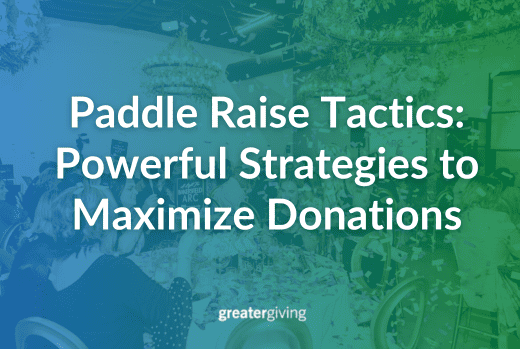
These effective, proven strategies will dramatically improve your paddle raise and help you raise more money than ever.
We were recently joined by Samantha Swaim of Fundraising Event Consultant at Swaim Strategies, a longtime partner of Greater Giving, for a webinar on how to develop a powerful paddle raise at your fundraising event.
Samantha walked us through some best practices for cultivating an atmosphere of generosity at your nonprofit event, and capturing audience enthusiasm in the form of fundraising during your special appeal. Keep reading for lots of insider tips and strategies to making your special appeal a big money-maker!
Let’s walk through some of the many helpful tips, tricks, and strategies covered in the webinar.
What is a Paddle Raise?
A paddle raise is a fundraising technique where attendees make direct monetary donations at an event. They do this by raising their paddles or bid cards at different giving levels. It creates a collective atmosphere of giving and helps raise funds quickly for a specific cause or project at charity auctions or fundraising events.
Nonprofits who apply these practices to their special appeals see 40-60% of their overall fundraising coming from their paddle raise.
Components of a Successful Paddle Raise
A professional benefit auctioneer: A professional knows how to work a room and build an atmosphere of generosity, then harness that energy into giving. The pros also tend to have their own way of doing things, such as bringing along a recorder to accurately capture bid numbers during a heated paddle raise.
Pre-committed gifts: This is work you’ll need to do in advance of your event. Start off by approaching your key donors about committing to a large gift in advance of your paddle raise. Donors who pre-commit will still raise their paddle during the live special appeal at the amount they’ve committed to help inspire others to give.
Increments: Begin your appeal with your highest pre-committed gift. Seeing paddles go up at the start of the special appeal inspires trust and confidence in the audience, so they’ll be more willing and eager to raise their own paddles later on. At your higher levels, hit increments that you have pre-committed gifts for.
A storyteller: You’ll need one individual to embody the mission of your nonprofit in their personal story. Samantha suggests sticking to a single person rather than trying to speak for a group, as people will get more invested in one individual story, generating enthusiasm and empathy.
First, distill the story of your “hero” and your nonprofit’s work into a 3-4 minute video, which you’ll want to show before your special appeal. Second, invite your “hero” onto the stage to tell their story themselves, and prime the audience to give.
A leaderboard or visual representation: Use a display or leaderboard during your paddle raise to visualize donations toward reaching your goal. Recognize donors on the screen as they give, and get more people excited to see their name up on the screen!
Best Practices for Special Appeals
– Use incentives to motivate giving, such as offering a prize for one winning donor among those who give at a certain level.
– If you have a donor or sponsor that people know well offering matching gifts, capitalize on that name recognition.
- Call it a “special appeal” or a “paddle raise.” Calling your appeal a “fund-a-need” means that you’re raising funds for a specific mission or need, and restricts those funds to that one need. During your special appeal, ask for direct cash support, making the funds unrestricted so they can be spent how they need to be spent. Remember that people are invested in the mission itself, and your appeal doesn’t have to be associated with a specific need to be effective.
- Timing is everything. Time your special appeal at the height of your audience’s energy. It crescendos over the course of the night, and at the peak is when you want to hold your special appeal. Samantha recommends holding part of your live auction first, then your special appeal, and then the second portion of your live auction to really capitalize on the audience’s enthusiasm.
- Active ask vs. passive ask. Make your special appeal giving an event, something that people want to take part in! Asking donors to quietly fill out a form at their table doesn’t work nearly as well in drumming up enthusiasm or interest with a live benefit auctioneer. Donors want recognition for their gifts and want to be a part of something big.
- Capitalize on matching gifts. Encourage more participation and more giving by offering corporate or major donor matching.
Embrace the power of paddle raise and witness the transformative results it can bring to your nonprofit.
Incorporating a paddle raise into your nonprofit’s fundraising strategy can be a game-changer in generating substantial donations and creating an atmosphere of collective giving. By utilizing Greater Giving Fundraising solutions, you can streamline the recording and processing of paddle raise donations, ensuring accuracy, efficiency, and transparency. Don’t miss out on the opportunity to maximize your fundraising potential and make a significant impact on your organization’s mission.
